HISTORY OF THE ALL SAINTS CHURCH
During the early years of the 20th century, many immigrants flocked to the United States. Many men from all parts of Greece and Asia Minor migrated to work in the steel mills of Weirton, West Virginia because they could find work at good wages. There were often given the most demanding, menial and dangerous jobs in the mill, but the pay was good. Their earnings allowed them to send money back home which enabled them to bring their families here and establish a new and permanent life.
Until the first Greek Orthodox Church was built, religious services were held in halls and private homes. At that time, transportation was limited to electric powered street cars. During special holidays, reservations had to be made with the street car company to acquire their services.
THE ROLE OF WEIRTON STEEL IN THE LIFE OF ALL SAINTS CHURCH
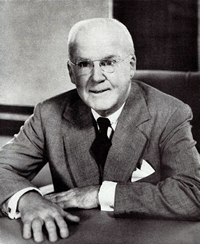 |
You cannot separate the story or the history of All Saints Greek Orthodox Church without mentioning the development of the Weirton Steel Company and the City of Weirton. In 1905, the Weirton Steel Company began as a small tin plate mill in Clarksburg, West Virginia. Mr. Ernest T. Weir and Mr. J.R. Phillips took the Clarksburg tin mill and turned it into a major unit of the country’s fifth largest steel producer at the time, the National Steel Corporation. As it outgrew its surroundings, the company was forced to consider a new location. |
In 1909, Mr. Weir himself selected the site on the Ohio River at what is now Weirton, West Virginia. The new plant had 10 hot mills, and finishing facilities were in operation before the end of the year. With the purchase of the tin mill in Steubenville in 1911, the company became the largest independent producer of tin plate. Mr. Weir, along with Mr. J.C. Williams, started the long planned step toward integrated steel production. In 1918, the name of the company was officially changed to the Weirton Steel Company.
From 1909 until 1947, Weirton was the largest unincorporated city in America. On July 1, 1947, Weirton and her sister cities, Holidays Cove, Weirton Heights and Marland Heights were consolidated in one municipality becoming the fourth largest city in the State of West Virginia.
EARLY CHURCH PLANNING
The men who worked in the mill lived in boarding houses. This included one room with a bed. Usually two men not only shared a room but also shared the expense of the room. All of the workers were willing to work a 12-hour shift for one dollar. The one dollar a day cost for the room was equally divided by the two men. When one was sleeping, the other man would be working in the mill. This was the life of the early immigrant steel worker.
Our immigrant forefathers wanted to prove that they were here to stay. Not only did they want to build a church where they could pray; they wanted to prove to the leaders of the company and to the Weirton community that they could be productive and active citizens.
Thus, in 1915, a group of Greek immigrants discussed plans with J.C. Williams, president of Weirton Steel, to construct a Greek Orthodox church. This man of foresight and wisdom felt that these men and women who had streamed into a strange land from the meager hillsides of Greece needed a place to worship God in their own way. Morally and financially, Mr. Williams assisted them in the purchase of a lot on Avenue A.
A building committee was established. Members included: John Samaras, president; Chris Leontaris, vice president; Angelo Sanderson and Peter G. Samaras, secretaries; Steve Delanis and Garif Papoutsis, treasurers. Committeemen included George Pandelios, Menelaus Zaorgianos, Gus Valles, George Thomas and Stelios Vanias. The committee with the aid of the Greek population worked diligently in every way possible to complete the church. Compulsory day wages, deductions from each Greek employee of the Weirton Steel Company and other contributions augmented the building fund.
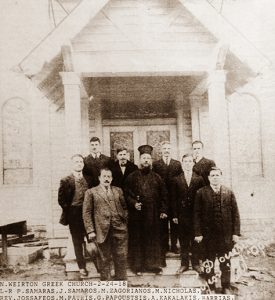 |
In the early spring of 1916, the cornerstone was laid. The church was officially established in 1917. As the building neared completion, regular elections were held and a parish council was elected on February 24, 1918. Once the church was built, Archimandrite Theodosios Loufakis of Pittsburgh officiated at the service to consecrate the church. The service is a sanctification and solemn dedication of worship space. |
NAMING THE CHURCHThe man credited with the naming of our church was Nicholas (Diamantides) Dimos. In Greece, all sections of the country have a patron saint. The new church name was chosen only after much careful thought and deliberation as each group of people wanted it named after their patron saint. Nick Dimos said, “Why not call it All Saints, because it includes all of the saints so greatly revered and honored by those of the Greek Orthodox faith” |
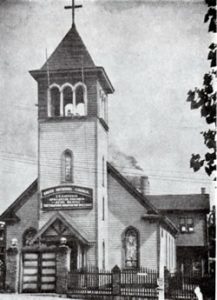 |
FIRST DIVINE LITURGY IN 1918
In 1918, the first Divine Liturgy was celebrated by Reverend Father Neophitas Iosafeos. Father Iosafeos was also an iconographer (a religious painter). Father Iosafeos slept in the church while working on the icons at All Saints. These Icons are still in use by the church and can be seen on the Icon Screen (Iconostasion) at the front of the church. Not only did he complete the iconography in the All Saints church, he was also commissioned to work on the many Icons in the St. Spyridon Greek Orthodox Church in Clarksburg, West Virginia. The beginning salary for the priest was $80 a month.
The first Divine Liturgy was celebrated on March 25, 1918 – an important day in the calendar of the Orthodox Church and the history of Greece: the Feast day of the Annunciation and Greek Independence Day. The Greek Orthodox community of Weirton and Steubenville finally had a place of worship. If you attended church in 1918, you would not find pews or chairs for the parishioners to sit during the service. The women stood on the left side; the men stood on the right. All young boys stood with their fathers. Strict discipline was enforced. This was the house of God.
Sunday was a special day. Besides a day of worship and rest, friends gathered at the church and enjoyed each other’s company. Talks of the village and family left behind were always major topics. The original church on Avenue A had a gazebo in the front yard. On holidays and special events, fireworks were set off, accented by live firing of guns in the air by parishioners. The Weirton citizens watched with interest when these special services were held outside.
GREEK PAROCHIAL SCHOOL
Soon after the establishment of the church, the first All Saints Parochial School was begun. It was located behind the All Saints Church on Avenue A. The Parochial School included Greek and English instruction. Mr. Philimon Sevastiades was the Greek instructor. Miss Pearl Cooper, Mrs. R.E. Campbell and Miss Mary Berger were the English instructors. Upon the completion of the three-year study in the Greek Parochial School, students were enrolled in the Weirton Public School on County Road.
Growing up in this community was a unique and memorable experience. The early students were taught to read the Greek language as many already spoke Greek fluently. They were also taught the history of Greece. The students celebrated the important holidays with poetry, plays and music. They were also instructed in the Orthodox Christian faith. The teachers were mainly from Greece. Good manners were emphasized as important as learning to read.
WEIRTON CHRISTIAN CENTER
During the 1920’s, in addition to the parochial and public schools, there was another special education landmark, the Weirton Christian Center. Besides religious education, the center provided education for the immigrants who were preparing for United States citizenship. The youth program included swimming classes, a gymnasium, basketball courts and roller skating. Many of the current members of All Saints Church experienced the life and nurturing of the Weirton Christian Center.
The Weirton Christian Center continues today with its educational programming for the youth of our community and classes for young men and women. A former youth of our parish, Mr. Michael Psaros, grew up in his grandparents’ home on Orchard Street in Weirton. Recently, in honor of his grandmother Eugenia Loufakis, Michael donated the “Evyenia’s House of Hope – A Place for Rebuilding Families” to the Weirton Christian Center, helping to ensure that WCC’s educational programs will continue to benefit those in need.
EARLY COMMUNITY ORGANIZATIONS
As our immigrant population struggled to exist in those early and difficult years, the following major organizations were born. All had the same goal…to help the Greek immigrant community life and thrive in America. As the Greek community grew, many social groups were also formed within the church. These social groups became active sponsoring dances, picnics and other activities. The goal of each social group was to help the poor and promote the Greek culture. Each island was represented by an organization bearing the name of the island including: the Chios Societies, the Kardamelian Society, the Paleophochian Societies, the Pan-Rhodian Society, the Agia Markella Ladies Society, the St. Photini Society and others.
1926 A.H.E.P.A. ….. G.A.P.A.
As the Greek population grew in the 1920’s, there was a need to develop a national brotherhood to unite the Greek people and to help them achieve their goals.
In 1922, the American Hellenic Educational Progressive Association known as The Order of A.H.E.P.A., came into existence in Atlanta, Georgia. At the same time, the Greek American Progressive Association, G.A.P.A., had its origin in McKeesport, Pennsylvania. Both organizations had similar goals: they sought to unify the Greeks of this country. They helped to better the lives of the immigrants through education. The organizations also helped immigrants to attain citizenship. During the early years, both organizations had active chapters in Weirton.
The AHEPA Chapter which was founded in May 1926, proved to be a stronger organization and is still in existence in the Weirton community. Today, instead of educating immigrants, the AHEPA provides scholarships for deserving youth and is active in church, Hellenic and community affairs.
1926 THE PHILOPTOCHOS SOCIETY
The local chapter of The Ladies Philoptochos Society was organized with Mrs. J. Samaras serving as the first president. The Philoptochos Society, “the friends of the poor,” is very active in the life of All Saints and is constantly engaged in projects to better the church and the Weirton community.
The society’s first purpose is to preserve the Greek Orthodox faith and traditions and to give aid and relief to those who may need the help of the church locally, regionally and nationally. The members’ enthusiasm has strengthened the church and aided in the progress of our parish. We congratulate all members past and present
1929 DAUGHTERS OF PENELOPE – Pallas Athene Chapter #276
The Mother Lodge of the Daughters of Penelope, the Senior Ladies’ Auxiliary of the Order of AHEPA, was founded in San Francisco, California on November 16, 1929. In 1954, Miss Georgette Frangakis and Miss Mary Stephens met with Mrs. Josie Chase, District Governor of the Daughters of Penelope to discuss the organization of a chapter in Weirton. The chapter was named Pallas Athene which is symbolic of the power and wisdom of the Goddess Athena.
The formal initiation of the Daughters of Penelope Athene Chapter was October 30, 1954, during the Buckeye District Conclave in Steubenville, Ohio. The goal of the Daughters of Penelope is to support the projects of the Order of AHEPA and all projects of the church. The first president of the Daughters of Penelope Athene Chapter was Mrs. Georgette (Frangakis) Fekaris.
1937 THE CHURCH CHOIR
The church choir enriches the Orthodox Liturgy by chanting the responses to the church services. It was first organized by the Reverend Father Demetrios Sylvestros and Greek School teacher Christalia Kakalakis Sanderson in 1937.
Due to economic times of the late 1930’s, the choir ceased to exist only to be reorganized in 1942 by the Reverend Father Demetrios Bouras and Chris Vrionidis. The choir was made up of female members until the end of World War II. After the war ended in 1945, men joined the choir.
1939-1963 SCOUTING YOUTH ORGANIZATIONS AT ALL SAINTS
The following scouting organizations are each covered in their own later sections of the Centennial Album. Although they are no longer active as parish youth movements, they played a major role in the life of many of the youth and now parish leaders of All Saints Church.
The Boy Scouts were started on May 31, 1939 by Mr. George Ellison. Troup #131 was the only Greek American troop of its kind in the surrounding area.
Cub Scout Pack #131 was organized by Father Stephen Natsis and Eagle Scout Pete Melonas in September of 1959, out of a growing interest by the younger boys in the scouting program. Both the Boy Scout Troop and the Cub Scout Pack were very active in the local Fort Steuben Council.
Camp Fire Girls became a reality in 1963 under the leadership of Father Stephen Natsis and Mrs. Ermione Loucas. The girls enjoyed various projects such as craftsmanship and art. They helped decorate the church during the holidays, conducted bake sales, candy sales and participated in educational tours.
In each organization, our youth learned by participation. Besides the many activities, the Scouts and the Campfire Girls were taught responsibility to their family, home, community and country. Each organizational leader who assisted our youth received the personal satisfaction watching their troop mature, rewarded by honors and medals. Many of the names you will see in each of the individual articles are still an active part of the life of our parish today including present Parish Council members. Another alumnus of Boy Scout Troop #131 is our present priest, Father Frank Milanese.
WE SALUTE OUR VETERANS
Between the years 1941 to 1945, the United States and its Allies were involved in the Second World War. Many parishioners went overseas to serve their country in one of the branches of the armed forces, leaving the elderly men, the women and younger siblings to carry on. Five young men lost their lives during these the war years. In their honor, our church hall was dedicated as the “All Saints Hellenic Memorial Hall.”
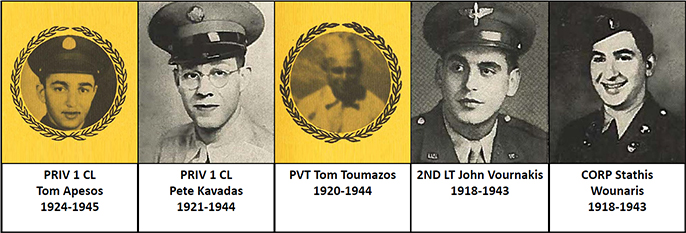
THE NEW CHURCH – WEST STREET – 1945
The Greek community grew despite the hard time everyone experienced during the Depression years of the 1930’s. Following World War II, even with many financial difficulties, the enthusiastic parishioners of All Saints Church sought to purchase land to build a new church. In the fall of 1944, the Parish General Assembly passed a resolution to build a new and larger church to meet the needs of the Greek community.
On January 18, 1945, Lots 19 and 20 of the Hookers Second Addition, West Street were purchased. The new Building Fund Committee was comprised of A. Bellas; J. Kikilides; J. Pandelios; G. Ellison; M. Arnas; A. Pappas; N. Moulakis; G. Mandalas; M. Bays; J. Karnoupakis; St. Stratros and Reverend Father Mandakis.
A sub-committee comprising of Alexander Bellas, John Frangakis, Mike Arnas and George Loucas met with Thomas E. Millsop, Mayor of Weirton and President of the Weirton Steel Company, to inform him of the plans the Greek community had to build an Orthodox church on West Street.
Alexander Bellas was fortunate to have visited Saint Sophia in Constantinople (Istanbul). He was in awe at the beauty of this church. As he viewed this architectural marvel, he was intrigued by the immense dome. The dome symbolized the transition from earth to heaven. Surrounded by beautiful gardens, this church covered several blocks and is one of the greatest structural designs in the world. Mr. Millsop was truly impressed with the possibility of the construction of such a structure for our community. He was deeply impressed by these dedicated men and challenges they were about to face. Mr. Millsop immediately pledged financial aid from Weirton Steel, thus enabling the community to go ahead with their plans.
Mr. Bellas pledged a donation of all the exterior brick and Nick Anas made a $6,000 donation, thereby launching the building fund drive. Donations, pledges and bonds contributed to the financial assistance. With all the financial contributions from the parishioners, the church was built without any outstanding debt.
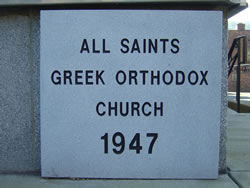 |
In 1947, the cornerstone of the new church was laid by His Eminence Archbishop Athenagoras, who was later to become His All Holiness Athenagoras, Ecumenical Patriarch of Constantinople. The plans for the building of the church included a hall for meetings and social gatherings, schoolrooms and various offices. |
| As work began on the structure, a familiar and continuous sight could be seen for many months on West Street. The young men who returned home from the war devoted many hours digging the foundation and carrying cement and bricks. Young women and children helped in the passing of the bricks to the workers. No one was exempt in building the House of God. |  |
On June 4, 1950, the new and beautiful Byzantine style All Saints Greek Orthodox Church was dedicated by Father Artman Mandakas. Originally the contract for the building budget was $175,000. As the construction began, the actual cost exceeded $250,000. The money raised for construction was provided by generous Greek Americans and many organizations. The Philoptochos Society donated $50,000 towards the building fund. Church dues were $30 a year.
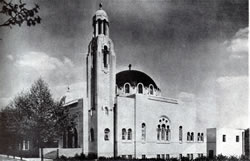 |
The outside of the church, the brickwork, the roofs and the towers were completed, but the interior of the church had yet to be decorated. In 1956, Mr. Constantine Triantafillou, a graduate of the Art School of the Polytechnic Institute of Athens, Greece, a recognized iconographer, artist and decorator, was contacted to adorn the interior of the church. The decor would be done in accordance with the dictates of Byzantine tradition. |
When the time came to move the Greek Orthodox Church from Avenue A to the West Street location, the interior of the church was not ready for religious services. The first services were held in the church hall. The stage of the church hall served as the temporary Iconostasion for the new parish.
The first couple to be married in the All Saints Greek Orthodox Church Hellenic Memorial Hall before the sanctuary upstairs was completed was Mike and Katie Giannirakis. The first couple to be married in the completed sanctuary upstairs was John and Elma Pandelios.
DOME REMODELING PROJECT – 1967
The dome of the “new” All Saints was originally of burnished copper. On a bright sunny day, it served as a beacon of light, hope and enduring faith for all citizens of Weirton. Unfortunately, immediately after the dedication, unforeseen roof problems emerged that required immediate repairs. Additional repairs were required on a continuous basis which affected not only the dome and the roof of the church but also the interior plaster. A permanent solution was needed. In 1967, the parish undertook a major remodeling project at a cost of $110,000. It was decided that the dome and bell towers should be covered with stainless steel.
Weirton Steel helped to make the new dome a reality through their help and generosity. The parishioners were deeply indebted to Anthony Gargaro, Weirton Steel engineer, who tirelessly and enthusiastically directed the project from inception to completion.
During the 50th Anniversary Banquet, “Alpha Omega” plaques in recognition of outstanding service to the church were personally presented by His Eminence Archbishop Iakovos to Anthony Gargaro and to J.H. Harris, Chairman of the Board of the Weirton Steel. His Eminence Archbishop Iakovos referred to Weirton as “The Steel City” and declared that All Saints Church was the only church in the United States with a stainless steel dome and belfry. This uniqueness must be attributed in a great part to the Weirton Steel Division. Archbishop Iakovos stated, “Your church can stand along all others as an expression of great faith in this nation and unyielding fidelity to the Christian religion.”
 |
The stainless steel dome is symbolic of the strength of the faith which the Greek people have in their Creator. The stainless steel exterior is symbolic of their belief in the future… “for just as the steel of the church will continue to endure, so shall the strength of the Greek Orthodox faith.” |
In addition to the exterior renovations, improvements were necessary to the interior of the church and Memorial Hall. The interior of the church was repainted, the Icons and other paintings were retouched and new electrical equipment and plumbing were installed. The All Saints parishioners contributed to the financial stability of the church through pledges, fund raisers and special donations.
PRESIDENT HARRY S. TRUMAN MEMORIAL – 1973
At the end of World War II, Greece was in dire need of financial and economic assistance. In March 1947, in what would be called the Truman Doctrine, President Harry S. Truman made an urgent appeal to the United States Congress for financial and economic assistance to Greece. He stated, “There is no other country to which democratic Greece can turn to.” In addition to financial aid, the United States provided experienced American administrators, economists and technicians to ensure that financial aid given to Greece was used effectively in creating a stable and self sustaining economy and improving its public administration.
In May 1963, a large statue of President Truman was unveiled in Athens, Greece, commemorating Truman as one of Greece’s greatest benefactors. In March 1964, Mr. Truman attended the funeral of King Paul I in Athens, Greece, as President Johnson’s personal representative.
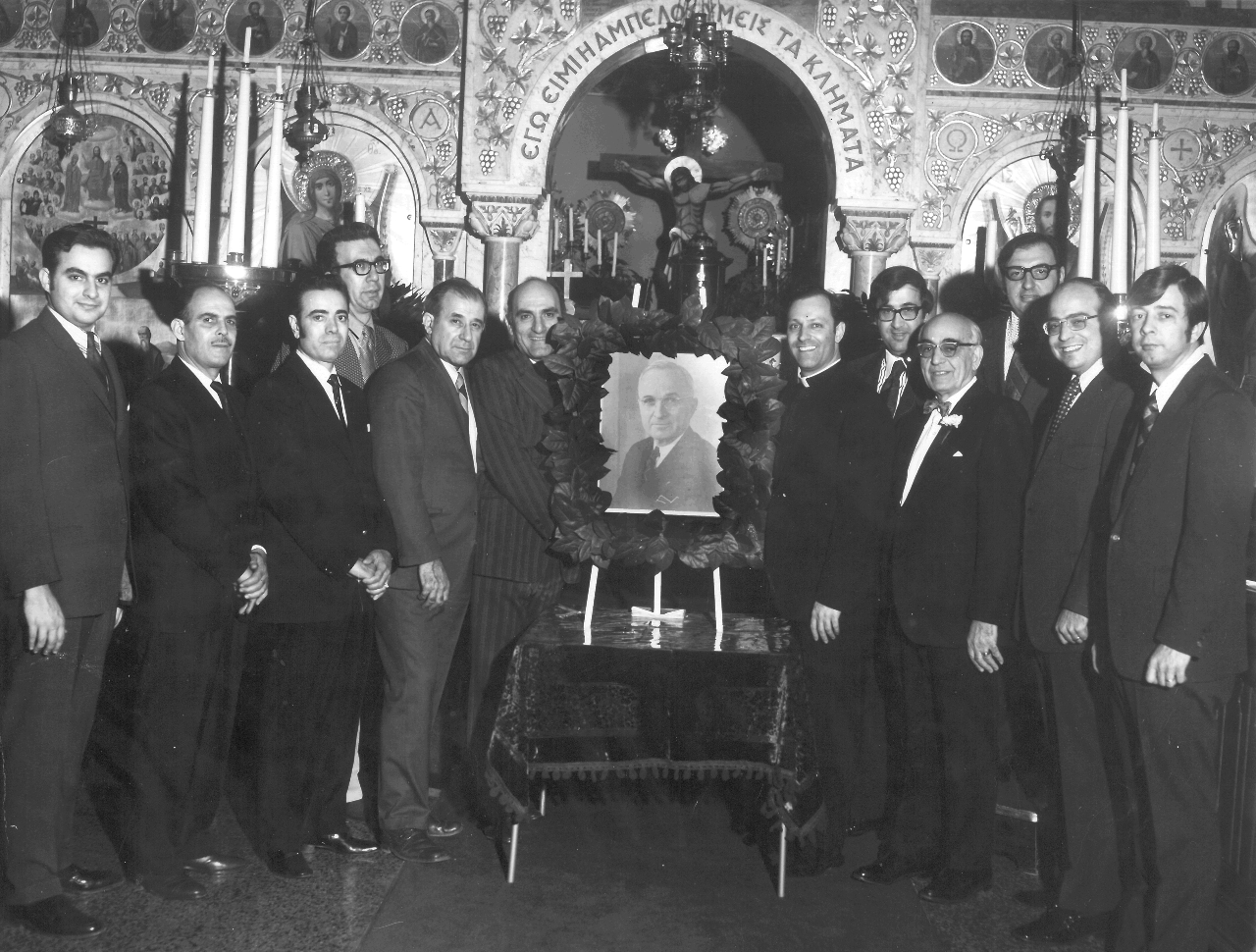 |
Former President Truman died at the age of eighty-eight on December 26, 1972. The thirty-third president of the United States was honorably remembered at All Saints for his support of Greece after World War II. In attendance were the governor of the State of West Virginia and the mayor of Weirton. All Saints Greek Orthodox Church was the only Orthodox Church in the United States to hold a memorial service for President Harry S. Truman. |
PROPERTY EXPANSION – ANNEX I, CHURCH OF CHRIST – 1980
With the increase of youth activities within the parish, it became necessary to seek additional property for space. When the Church of Christ Congregation moved to another location in 1980, the parish voted to buy this property that was immediately adjacent to the church. It was named Annex I.
All Saints church purchased it for $54,000. It was initially rented to other churches in our community. Over the years, little expense was put in the repairs of the building because the first renters did the repairs themselves until the facility was too small for their growing congregation. The building was in dire need of repairs and in 2002 became vacant. The All Saints community decided that the cost was far too great and tearing it down to become a parking lot was in the church’s best interest.
POST OFFICE PURCHASE – ANNEX II – 1984
The Cove Post Office Building – Annex II – was purchased for $106,075 on July 12, 1984. Rentals from the United States Postal Service helped to pay off the building. This building provided storage, classrooms and a gymnasium where our youth could gather. The leasing of the front of this building to the Post Office provided the church with mortgage payments. The last mortgage payment for Annex II was made in December 1992.
At the 70th anniversary in 1987, George Kilavos presented a check in the amount of $12,000 to the parish president George Kohelis to renovate the Cove Station Post Office building. His Grace, Bishop Maximos of Pittsburgh, dedicated the new Sunday school classes in the newly purchased Cove Station Post Office building.
The main floor was converted into a non-regulation size gymnasium and youth activity room. The downstairs area was converted into nine classrooms and offices for the church’s religious education program and meeting rooms for church groups. The parish priest at that time was Father Terry Linos, with Mrs. Georgette Fekaris supervisor of Sunday school. In later years, this additional property has allowed the parish to enhance the “Greek Food Festival” experience.
In addition to participation in the Boy Scouts, the Cub Scouts or the Camp Fire Girls, our parish youth also became involved in the growing youth ministries of the Greek Orthodox Church. Archdiocesan church youth ministries including Hellenic Orthodox Primary Education (H.O.P.E.), Junior Orthodox Youth (J.O.Y.), Greek Orthodox Youth of America (G.O.Y.A.) and Young Adult League (Y.A.L.) met the needs of our church youth on a diocesan and national level.
CHURCH DIRECTORY (OUTSIDE MARQUIS) – 1983
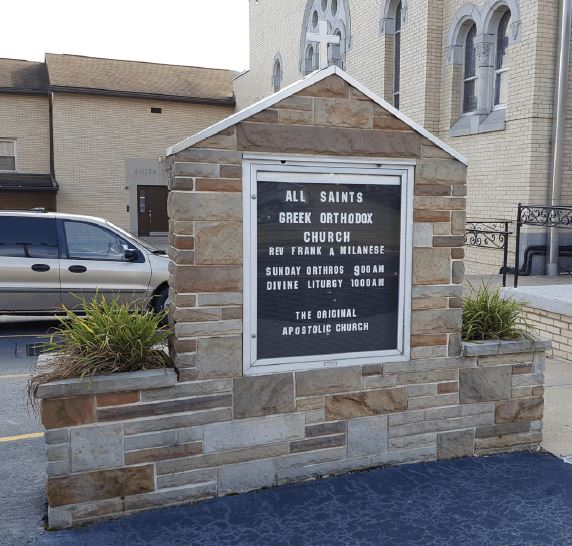 |
The Agia Markella Ladies Society made a major contribution to our church on July 22, 1983. Through donations collected by the parishioners and friends, the ladies society donated the stone and stainless steel directory to the All Saints Church. The directory was designed by Harry Ameredes. The stonemasons were Deno Galanos and Ted Charnik under the supervision of George Sotraidis. The directory is made of stone with the stainless steel cap and cross on top to match that of the church. |
REMODELING PROJECTS DURING THE 1990’s
In July 1990, the All Saints parish council approved the construction of a walk-in cooler and freezer which would greatly help with the All Saints Greek festivals. This eliminated renting of coolers and freezers which was difficult because of limited space.
In January 1992, our General Session approved the renovation of the church’s kitchen. The new ovens, stove, cabinets, metal tables, new ceramic floors and walls are just a few of the changes that occurred. These additions greatly improved the working conditions and the efficiency of the kitchen.
THE 21ST CENTURY – PRESERVING THE LEGACY OF OUR PARENTS AND GRANDPARENTS
In 2003, the All Saints community undertook a major renovation project to “Preserve the Legacy of Our Parents and Grandparents,” which included the cleaning of the stainless steel, installing new roofing material on all the roofs (12 separate ones in all), restoring the brick and precast stone, restoring the front steps and entrance ramp, replacing the front entrance and doors, and repairing deteriorated plaster on the interior of the church. The project work was completed in May, 2004, costing hundreds of thousands of dollars. Having thus completed this major renovation, the parish has now established an 10-year maintenance fund to enable the ongoing maintenance of the physical structure of the church.
The full scope of the renovations made to our beloved parish since 2003 can be seen on our renovation page.
